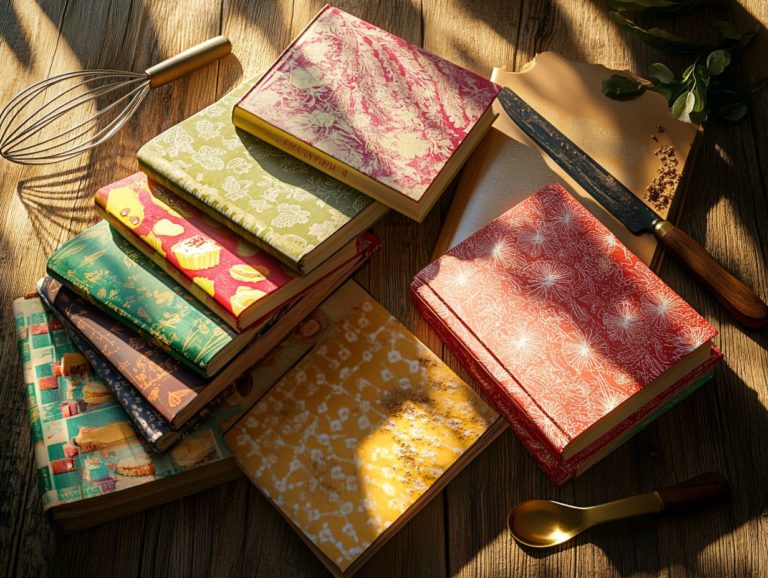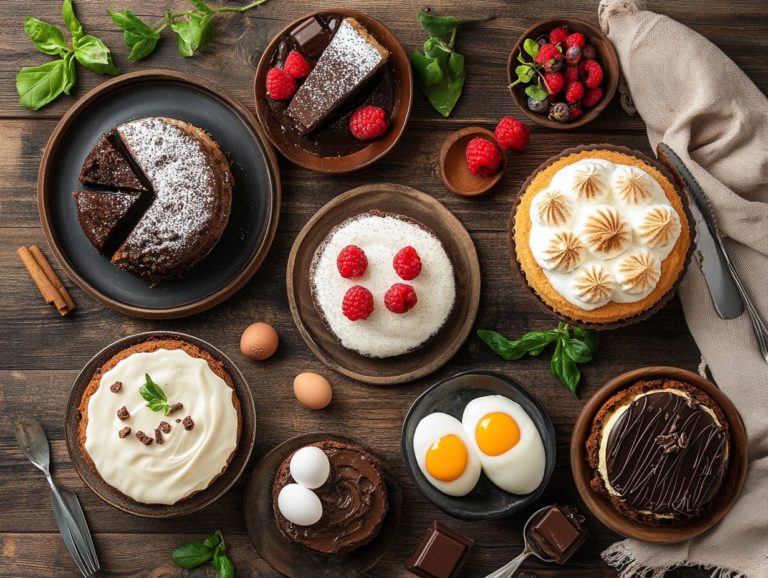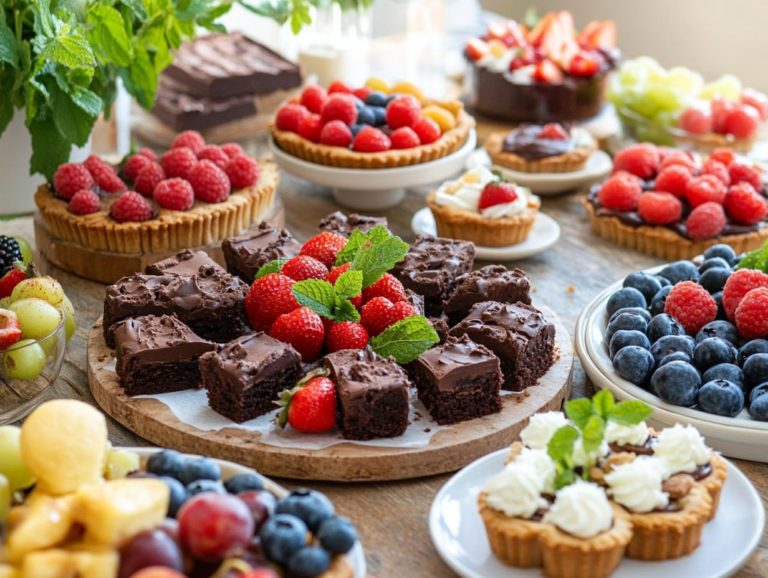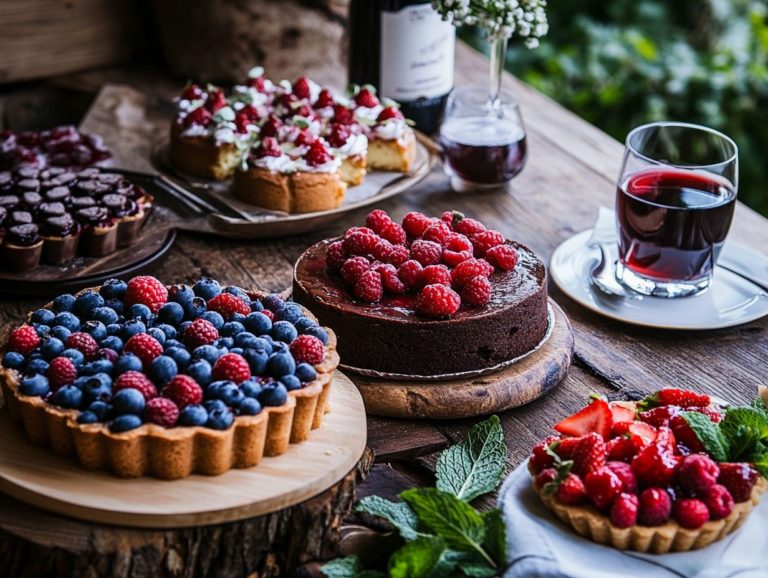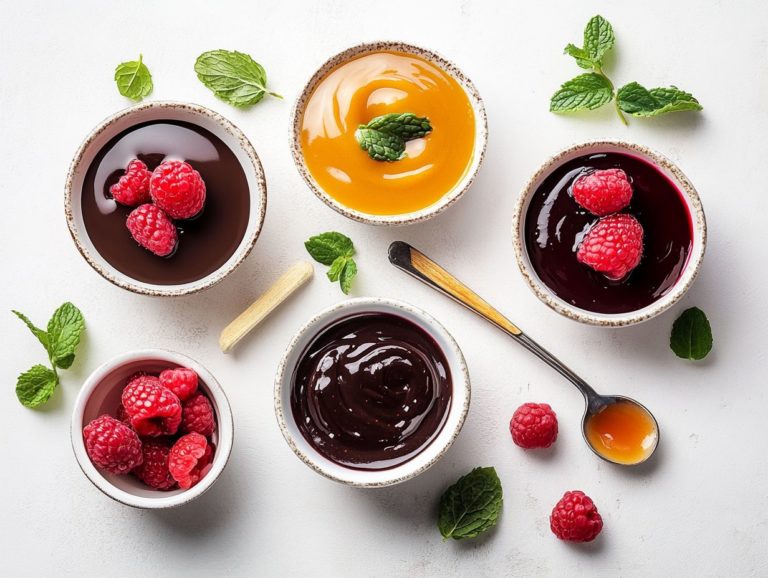What Are the Essential Baking Tips for Beginners?
Contents
The Beginner s Guide to Baking
Baking may appear intimidating for beginners, but armed with the right tools, tips, and techniques, you can effortlessly whip up delightful treats from scratch.
This guide meticulously outlines the essential tools you’ll need, from measuring cups to mixing bowls, ensuring that everything you require is readily at your fingertips for your baking journey.
It delves into the fundamental ingredients that form the backbone of beloved recipes, along with key baking techniques that you ll want to master. This guide also highlights common pitfalls to avoid, empowering you to bake with confidence and achieve flawless results every time.
Understanding baking math and precise measurements can greatly impact the success of your baking.
Key Takeaways:
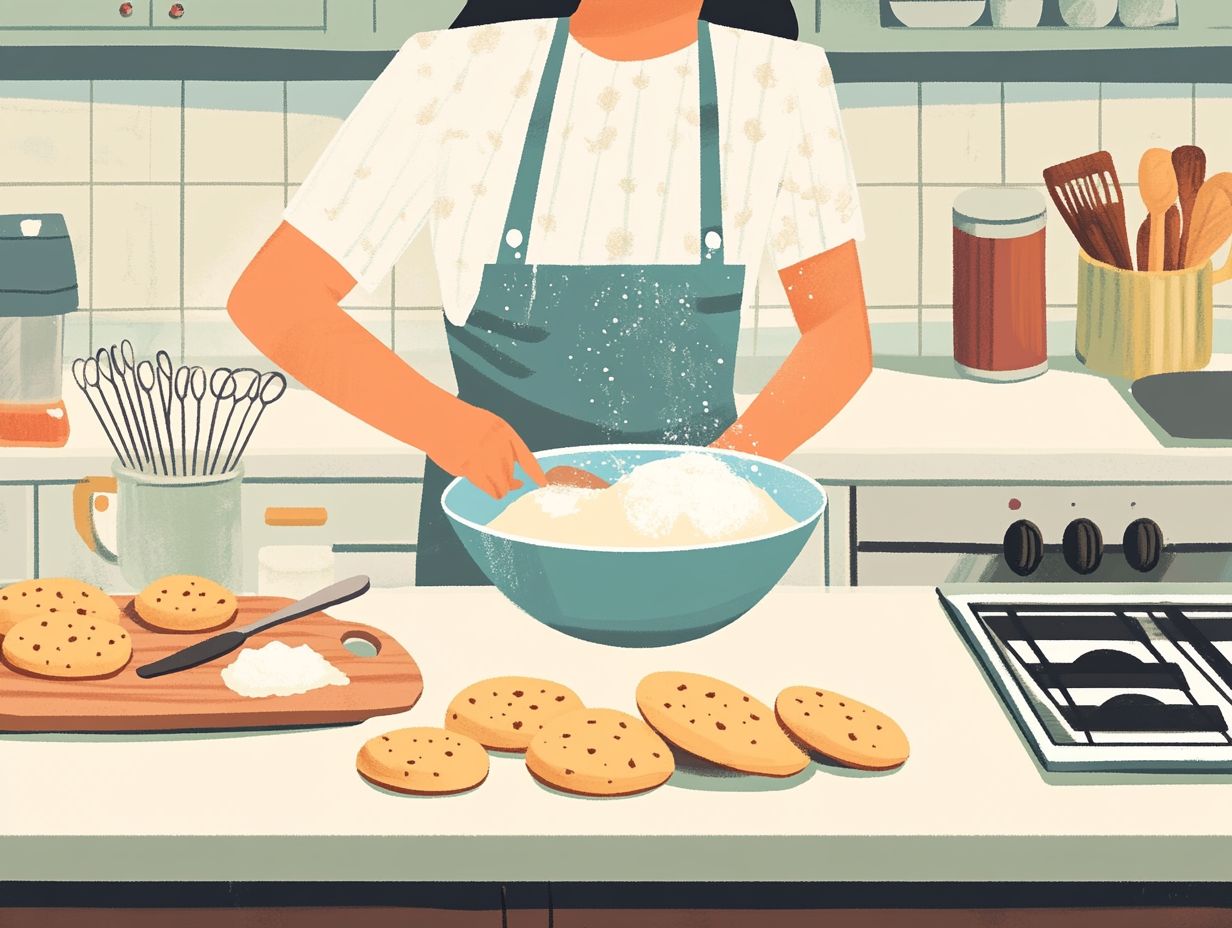
- Invest in essential tools like measuring cups, mixing bowls, and baking pans to set yourself up for baking success.
- Understanding basic ingredients like flour, sugar, and baking powder is key to creating delicious baked goods and avoiding common baking mistakes.
- Proper techniques such as preheating the oven and correctly measuring ingredients can make a huge difference in the outcome of your baked goods. Practice baking methods like the creaming method and mastering the whisking technique.
Essential Baking Tools and Equipment
As you embark on your baking journey, you must equip yourself with the right tools to succeed from the start! Essential kitchen tools for baking include measuring cups and spoons, which guarantee you’re using the precise quantities needed for flawless results.
Accurate measuring is paramount in the baking process, and utilizing a kitchen scale can further enhance your precision. Mixing bowls are essential for combining your ingredients, while versatile baking pans are a must-have for creating a range of delights, from cakes to cookies and pastries.
Don t overlook the importance of a whisk for aerating your mixtures and a spatula for gently folding in ingredients. Investing in quality ingredients will significantly affect your baking results.
Grasping the significance of these essentials will not only elevate your beginner baking skills but also pave the way for your culinary triumphs. Incorporate baking schedules and practice your baking skills to achieve the best results.
1. Measuring Cups and Spoons
Measuring cups and spoons are essential tools for any baker, ensuring that you achieve precise measurements for both dry and liquid ingredients, which is crucial for precision baking.
These instruments come in a variety of forms, including nested measuring cups, perfect for scooping up dry ingredients such as flour and sugar, and liquid measuring cups complete with spouts for effortlessly pouring liquids like milk or water.
Additionally, specialized measuring spoons are tailored for those smaller quantities, ideal for ingredients like baking powder, vanilla extract, and spices.
In the realm of baking, precision is of utmost importance; even the slightest deviation in your measurements can lead to unexpected results, such as a cake that turns out too dense or cookies that spread too thin.
Thus, mastering proper measuring techniques and understanding baking ratios can significantly elevate your baking experience, ensuring consistently delightful results that will impress everyone who tastes your creations.
2. Mixing Bowls: Essential Kitchen Companions
Mixing bowls are your go-to kitchen companions, showcasing a range of sizes and materials that are essential for combining ingredients during the baking process. Proper kitchen organization will help streamline your baking practice and improve your efficiency.
These bowls play a pivotal role in different baking techniques. Whether you re whisking eggs, creaming butter, or gently folding in delicate components, selecting the right size is key. Opt for larger bowls when you need to accommodate more ingredients without the risk of spills, while smaller bowls are ideal for small batches or intricate recipes that require your utmost attention.
The choice of material be it glass, metal, or plastic also influences your mixing results. Metal bowls excel at retaining cold, making them perfect for whipping cream, while glass bowls offer the advantage of easily monitoring the consistency of your ingredients. Understanding your kitchen tools and their interactions with ingredients is part of the baking science that leads to successful outcomes.
By organizing these kitchen tools, you not only save time but also enhance your efficiency, making cooking easier and more enjoyable.
3. Baking Pans: Achieving Perfect Shapes
Baking pans are essential for achieving the perfect shapes and textures in your baked creations. Choosing the right type can profoundly influence your results.
Consider the classic round cake pans, which help you craft impressive layers for a tall, celebratory cake. The versatile muffin tins are your trusty allies for whipping up a delightful batch of breakfast treats in no time. Cookie sheets, with their flat surfaces, excel at providing even heat distribution ideal for perfectly crisp cookies. Loaf pans are vital for achieving that ideal rise in bread or pound cake.
Knowing how oven temperature affects different pans is crucial for baking success. As you embark on your baking adventures, consider how different materials be it metal, glass, or silicone interact with your ingredients, as this can affect baking temperatures and times. Selecting high-quality ingredients is equally crucial; the way they react with the pan materials can be the fine line between a culinary triumph and a baking failure that can be frustrating. Keep a close eye on baking time and make necessary adjustments based on your specific oven and environment.
4. The Whisk: A Key Baking Tool
A whisk is an essential baking tool that helps you incorporate air into mixtures, which is vital for achieving that light and fluffy texture in your baked goods.
You ll find various types of whisks, each crafted for specific tasks. For instance, a balloon whisk, with its wide, rounded shape, is perfect for whipping cream or aerating egg whites. A flat whisk shines when blending sauces and gravies. If you’re using non-stick cookware, a silicone whisk is your best friend, preventing scratches while effectively mixing batters or smoothly combining sauces.
Mastering the proper whisking technique not only elevates the texture of your bread and cakes but also ensures that dry ingredients are evenly combined, leading to perfectly uniform baking results. Knowing which whisk to use for each task is crucial for anyone looking to achieve baking success. Understanding the role of room temperature in your ingredients can also significantly improve your baking outcomes.
So, grab your whisk and start experimenting today for the best results!
5. Spatula
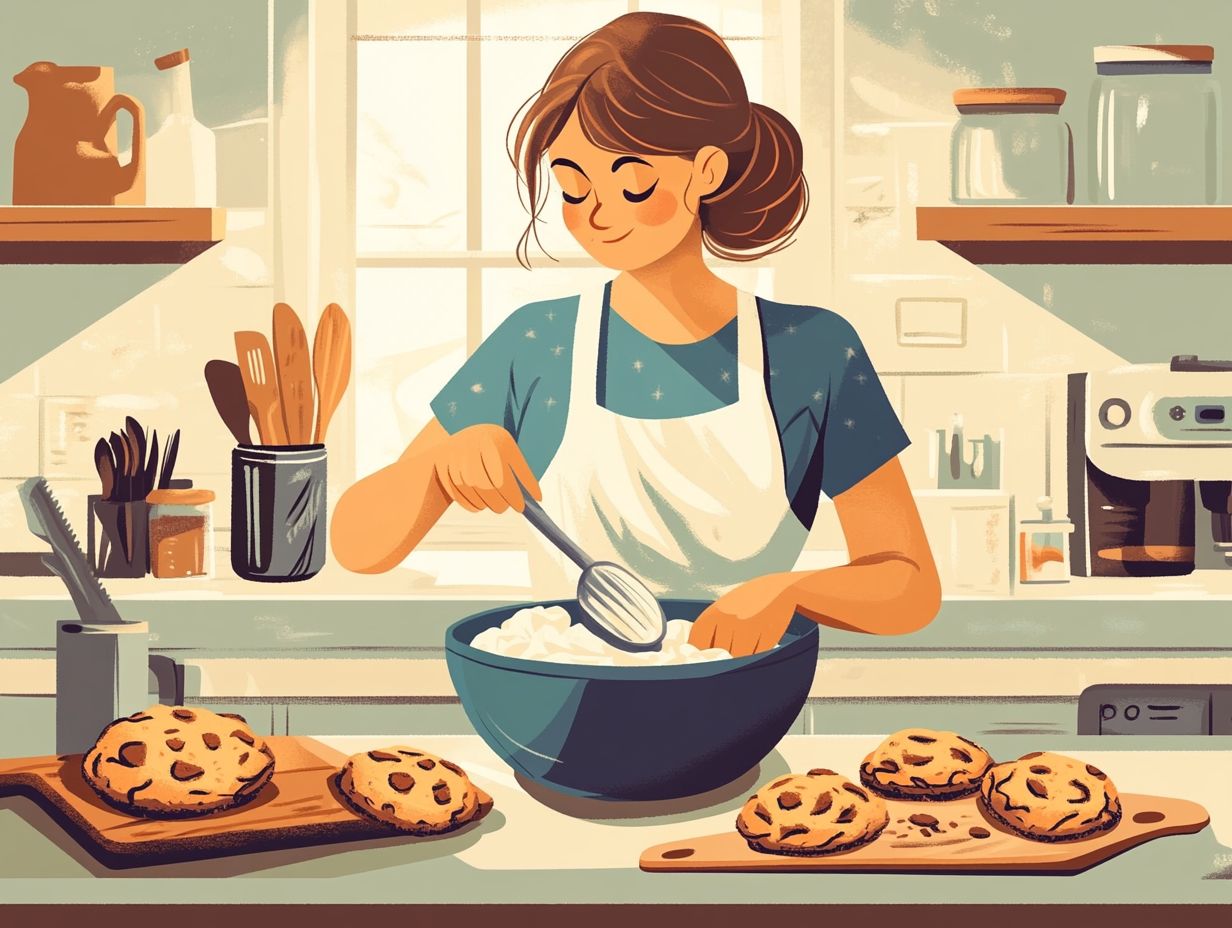
A spatula is an essential tool in your baking kitchen, perfectly designed for folding, scraping, and spreading mixtures with precision in your recipes.
It aids in blending ingredients seamlessly and boasts various types, each crafted for unique purposes that can significantly enhance the texture and consistency of your baked goods. The silicone spatula quickly becomes your best friend; its heat resistance and flexibility make it ideal for delicately folding in whipped cream or incorporating air into batter without deflating it.
A rigid metal spatula is great for lifting cakes and cookies from baking sheets, ensuring your creations maintain their beautiful shape. A rubber spatula is equally essential for scraping down the sides of mixing bowls, preventing any precious ingredients from going to waste and guaranteeing thorough mixing.
Incorporating ingredient substitutions can be a game changer, offering flexibility in your recipes and encouraging experimentation.
By understanding the distinct roles of these baking tools, you can elevate your baking techniques and achieve consistently impressive results.
Basic Ingredients for Baking
Grasping the fundamental ingredients in baking is crucial for any aspiring baker, as each component plays an essential role in the chemistry of your creations. Understanding the baking science behind each ingredient helps you troubleshoot and avoid common baking failures.
Flour, for instance, serves as the backbone, providing essential structure; sugar adds delightful sweetness and aids in achieving that beautiful golden-brown hue. Eggs bring moisture and richness to the mix, while baking powder and baking soda help your baked goods rise. Don t overlook salt, as it enhances flavor beautifully.
Understanding the unique function of each ingredient from binding to rising is key to achieving perfect baking results and ensuring a truly rewarding baking experience.
1. Flour
Flour serves as the cornerstone of most baked goods, providing the essential structure and texture that recipes rely upon. Each type of flour, with its distinct properties, plays an integral role in the baking process.
All-purpose flour, with its moderate protein content, is your go-to option for a versatile range of recipes, from cookies to muffins. If you’re aiming for something with a bit more chew, bread flour is key. Its higher protein content promotes gluten development, resulting in that delightful texture perfect for artisan loaves and rolls.
When creating delicate cakes and pastries, cake flour is your best friend. Its fine milling and low protein content produce tender crumbs that melt in the mouth.
The way flour interacts with other ingredients, such as liquids and fats, significantly impacts the overall dough structure and moisture retention, shaping the final outcome.
By understanding these different flour types and their effects on the science of baking, you elevate your ability to create truly delicious treats.
2. Sugar
Sugar does more than just sweeten your baked goods; it plays a crucial role in the browning process and the overall texture of your treats. Baking tips for beginners often include understanding how sugar interacts with other ingredients to produce desired results.
Understanding the various types of sugar can significantly impact your favorite baking recipes. Granulated sugar is typically your go-to for most baking, offering a clean, sweet flavor while contributing to a light and airy texture. In contrast, brown sugar, which contains molasses, brings a deeper richness and moisture to your creations, enhancing their chewiness.
Then there s powdered sugar, perfect for crafting smooth frostings and glazes, adding delicate sweetness without disrupting the texture too much. By opting for high-quality sugars and other quality ingredients, you elevate the taste and enhance the visual appeal of your treats, ensuring that every bite is as delightful as the last. Using the right kitchen tools and understanding the baking process can make all the difference.
Baking Essentials for Beginners
3. Salt
Salt is an essential ingredient in baking, elevating flavor and strengthening the gluten structure in your doughs and batters. Mastering beginner baking often involves understanding the role of such baking essentials.
But there’s so much more to salt than meets the eye. Different types of salt can play unique roles in your baking endeavors. Take kosher salt, for example. Its coarser, flakier texture allows you to regulate sodium levels with precision, giving you greater control over seasoning and texture in your recipes.
Then there’s sea salt, which comes in various grain sizes. When used as a topping for breads or cookies, it adds delightful bursts of flavor and a satisfying crunch.
Salt does more than just balance sweetness; it influences fermentation (the process where yeast creates bubbles that make dough rise) too, enhancing the overall flavor profile and texture of your baked goods.
This delicate balance showcases how incorporating various salts can transform a simple recipe into something truly extraordinary.
4. Baking Powder and Baking Soda
Baking powder and baking soda are essential leavening agents that elevate your baked goods, allowing them to rise beautifully and achieve that perfect texture you desire.
While they may appear similar at first glance, their distinct chemical properties and reactions can dramatically influence the outcome of your recipes. Baking soda is a pure alkaline compound that needs an acid to spark a reaction. Baking powder comes complete with both the acid and base required for effective leavening.
This distinction makes it imperative that you use the correct ingredient; substituting baking powder for baking soda can leave your baked item disappointingly flat and dense.
Precise measurements of these ingredients are crucial. An excess of either could impart undesirable flavors or textures to your creations. By grasping these nuances and employing accurate measuring techniques, you can significantly enhance your baking prowess and ensure consistently delightful results.
This is where understanding baking ratios and baking math becomes particularly important.
5. Butter
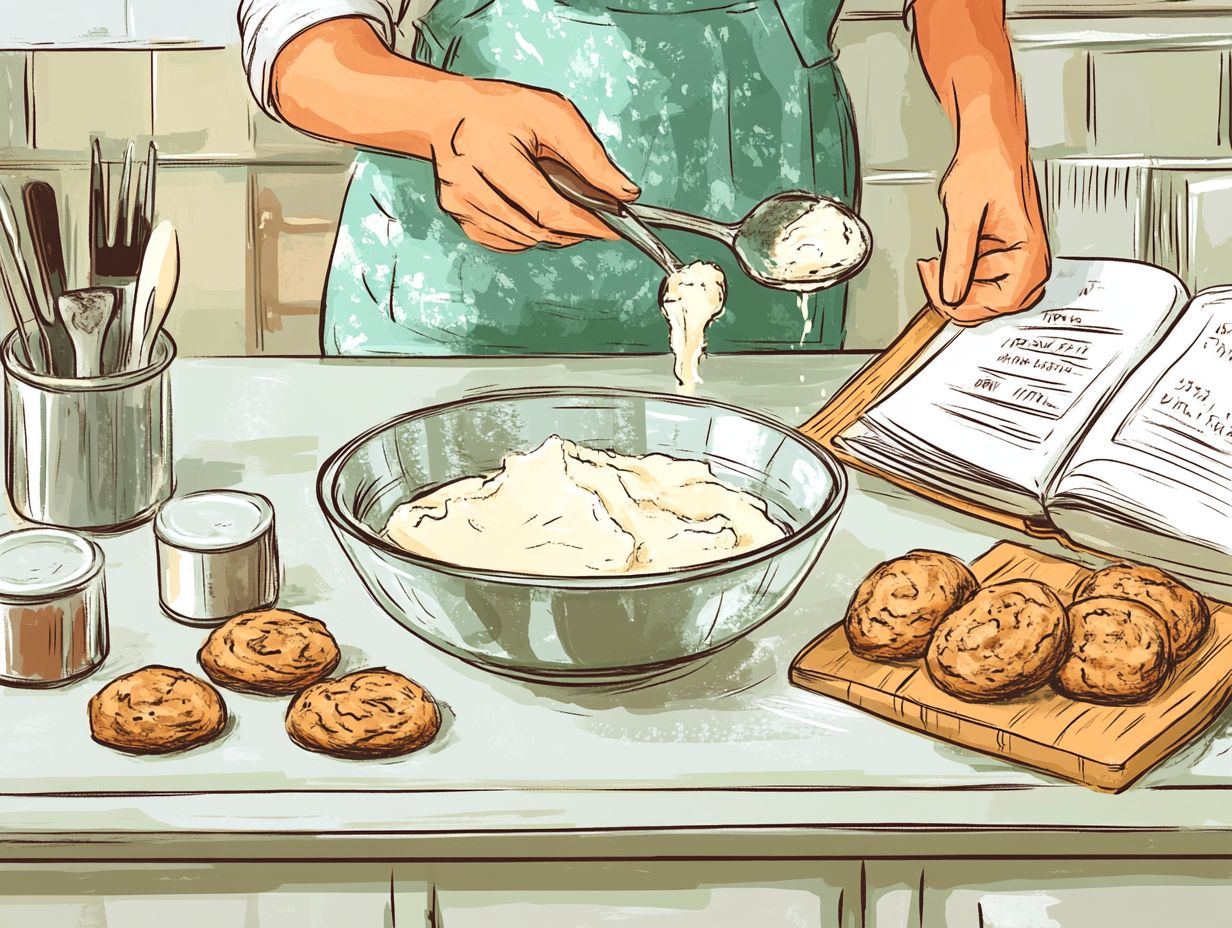
Butter is an essential ingredient that brings richness, flavor, and moisture to your baked goods, playing a pivotal role in both texture and taste. Mastering the use of butter is a fundamental aspect of baking techniques and contributes significantly to the overall baking results.
You ll find butter available in various forms, including unsalted, salted, and clarified, each serving distinct purposes in your baking endeavors. Unsalted butter is often the go-to choice for its purity, allowing you to control the salt levels in your recipes.
While salted butter may be convenient for spreading on toast, it can sometimes throw off your formulas in baked items. Therefore, when precision matters, it s generally best to stick with unsalted.
Clarified butter, with its milk solids removed, is fantastic for high-temperature baking and frying, lending a delightful nutty flavor without the risk of burning.
Achieving the perfect room temperature for butter is crucial, especially in techniques like the creaming method. Here, soft butter blends seamlessly with sugar, creating a light and airy texture that forms the basis for your cookies and cakes.
The significance of this step cannot be overstated. It profoundly influences the final product s rise and crumb structure. Consistent practice and understanding of baking methods can help you achieve the best results.
Now that you know the essentials, why not try incorporating these tips in your next baking adventure? Happy baking!
Important Techniques for Baking
Mastering essential baking techniques is crucial for beginners. These skills form the foundation of baking and dramatically influence your creations’ outcomes.
Baking tips for beginners often emphasize the need to understand baking methods and practice them regularly.
For instance, ensuring that you preheat your oven to the correct temperature guarantees even cooking. Precise measurement of ingredients is key to achieving accurate baking results. Investing in good baking equipment and kitchen tools can greatly aid in this process.
The right mixing techniques whether you’re employing the creaming method (which involves mixing butter and sugar until fluffy) for cakes or simply whisking dry ingredients play a pivotal role in achieving the desired texture for your baked goods.
Understanding how different oven temperatures impact baking times and outcomes is vital to avoiding all-too-common baking failures and disasters. Baking temperature is a critical factor that influences the entire baking process.
1. Preheating the Oven
Preheating the oven is an essential step in your baking journey. It guarantees your baked goods cook evenly right from the get-go.
This critical practice allows the oven to reach the desired temperature before adding batter or dough. This promotes optimal rising and browning.
When you skip this step, you risk uneven cooking; that initial warmth is vital for the reactions needed for baking.
Depending on the type of oven you re using be it conventional, convection, or gas expect to spend about 10 to 20 minutes on preheating. Grasping how these elements influence the baking process can dramatically enhance your final results.
By consistently preheating, your cookies will be perfectly crisp, your cakes will rise to glorious heights, and your bread will develop that irresistible crust. This step is vital for the best results in your baking journey!
2. Properly Measuring Ingredients
Measuring ingredients accurately is absolutely crucial in baking; even the slightest deviation can lead to baking failures or unexpected results.
Using a kitchen scale and other baking tools can help ensure precision.
When you achieve precise measurements, you not only obtain the desired texture and flavor but also ensure that your baked goods remain consistent.
For dry ingredients, employing techniques like the spoon-and-level method for flour or using a straight edge to scoop and level can significantly elevate your baking game. This is one of the many baking tips for beginners that can help you achieve better baking results.
When dealing with liquid ingredients, opt for a clear measuring cup that features volume markings for precise pouring. A kitchen scale is often considered the gold standard for accuracy, providing weight measurements that completely remove the guesswork associated with volume-based methods.
To further improve your precision, it s wise to calibrate your scale regularly and invest in high-quality measuring tools. This way, you can ensure that you achieve the best results every time you step into the kitchen.
3. Mixing Techniques
Mixing techniques are essential in baking, and they greatly influence the texture and consistency of your final product.
Whether you re employing the creaming method for cakes or opting for a straightforward whisking approach, mastering these baking techniques can significantly improve your overall baking skills.
Each technique plays a pivotal role in how your ingredients come together, shaping the outcome of your baked goods. Take, for example, the folding technique, which is often used in recipes like souffl s. This method gently incorporates egg whites into the batter, resulting in a delightful light and airy texture.
The muffin method involves combining dry and wet ingredients separately before mixing them, ensuring a tender crumb that’s perfect for quick breads and muffins. Such techniques form an essential part of your kitchen experiences and baking practice.
Regarding cookie dough, using the paddle attachment in your electric mixer is a wise choice it provides the necessary aeration without overworking the gluten.
By understanding when and how to utilize these techniques, you not only elevate your baking process but also significantly enhance the taste and quality of your creations.
4. Understanding Oven Temperatures
Understanding oven temperatures is essential for your baking success. Different recipes specify precise baking temperatures that directly impact cooking time and texture. This understanding is crucial for managing your baking schedules and ensuring baking successes.
The ability to set your oven to the correct temperature can be the deciding factor between a cake that rises to perfection and one that turns out flat and dense. For example, you might commonly set your oven to preheat at 350 F (approximately 175 C) for most baking tasks. However, a delicate souffl will require a more gentle approach at 325 F (around 160 C). Understanding these nuances is a part of accurate baking and good baking habits.
Converting between Fahrenheit and Celsius can be tricky, but mastering this skill is vital for achieving your desired outcomes. Additionally, factors such as baking altitude, the moisture content of your ingredients, and whether you re using a conventional or convection oven can profoundly influence your baking times and the overall quality of your creations.
With this knowledge at your fingertips, you can experiment with confidence and tailor recipes to suit your unique baking conditions.
Common Mistakes to Avoid in Baking
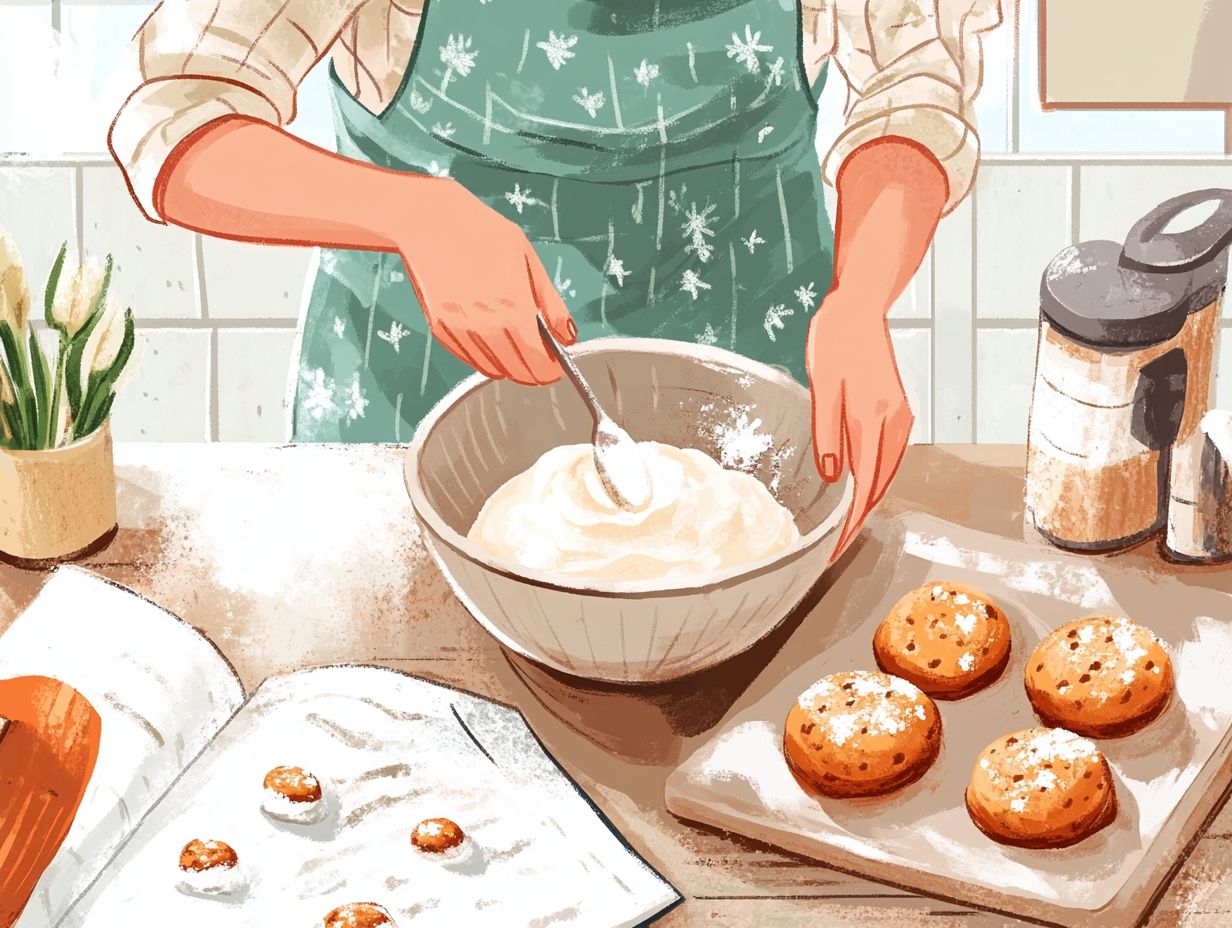
Avoiding common mistakes in baking is crucial for achieving outstanding results and steering clear of culinary disasters that can lead to frustration. Many beginners often grapple with overmixing the batter, which results in a dense texture. Others may use cold ingredients, throwing the entire baking process off course.
Seeking baking advice from experts can help mitigate these mistakes and elevate your baking game. Neglecting to test for doneness or failing to follow the recipe can lead to easily preventable baking mishaps. Embracing these challenges and learning from them is an integral part of your journey toward mastering the art of baking and refining your skills.
1. Overmixing the Batter
Overmixing the batter is a classic baking blunder that can turn your cakes and muffins into tough, dense disappointments. This happens because vigorous mixing promotes excessive gluten development, which transforms the tender crumb into a chewy texture, robbing your baked goods of the lightness they truly deserve.
Grasping the proper mixing technique is crucial. Instead of letting a mixer run wild, opt for gentle hand-stirring or mix only until the dry ingredients are just incorporated. This method preserves a delicate structure, paving the way for a moist and airy final product. Remember, patience is key; finding that perfect balance can lead to baked delights that are both flavorful and a joy to savor.
2. Using Cold Ingredients
Using cold ingredients, especially in recipes that call for room temperature butter or eggs, can drastically impact the texture and rise of your baked goods.
In baking, grasping the importance of temperature is essential to achieving the results you desire. For example, cold butter may struggle to cream effectively with sugars, resulting in dense cookies instead of the light, fluffy treats you envision. Likewise, eggs taken straight from the fridge can fail to incorporate smoothly, disrupting the emulsification process necessary for a delicate, airy cake batter.
For those just starting their culinary journey, a straightforward yet powerful tip is to set out your butter and eggs at least 30 minutes before diving into your recipe. This small adjustment facilitates better blending and significantly enhances the lightness and overall quality of your finished product.
By practicing this technique, you not only ensure more consistent results, but also lay a solid foundation for mastering the art of baking.
3. Not Testing for Doneness
Not testing for doneness is a common oversight. This can lead to baked goods that are either undercooked or overcooked.
Perfectly cooked cakes, cookies, and loaves of bread are essential for achieving rich flavors and delightful textures. You can use various techniques to check if your baked creations are ready.
For example, when testing a cake, simply insert a toothpick into the center. If it emerges clean, your cake is good to go.
With cookies, keep an eye on those edges. When they turn a lovely shade of golden brown, they re typically spot on. For bread, a quick tap on the bottom should yield a hollow sound, a telling sign that it has achieved the ideal crust and crumb.
Paying close attention to timing and visual cues helps you refine your baking skills. Don t risk ruining your baked goods; always test for doneness!
4. Not Following the Recipe
Not following the recipe precisely is one of the most common baking mistakes. This often leads to unexpected results and baking failures.
As you embark on your baking journey, it s essential to recognize that each ingredient and measurement plays a vital role in achieving that perfect balance of flavors and textures. Inaccurate measurements or spontaneous substitutions can disrupt the delicate chemistry needed for delicious items like cakes and cookies to rise properly or reach the intended consistency.
To enhance your baking experience, take the time to read through recipes thoroughly before you dive in. Familiarize yourself with all the ingredients, understand the tools and techniques required, and anticipate baking times. Mastering baking builds your confidence and skills, ensuring delightful outcomes every time.
Frequently Asked Questions
What are the essential baking tips for beginners?
- 1. Start with simple recipes: As a beginner, it’s important to start with easy recipes to build your skills and confidence in baking.
- 2. Use quality ingredients: The quality of ingredients greatly affects the outcome of your baked goods, so try to use the best you can afford.
- 3. Measure accurately: Baking is a science that requires precise measurements. Invest in a good set of measuring cups and spoons.
- 4. Preheat your oven: Always preheat your oven before baking to ensure even heat distribution and proper rise of your baked goods.
- 5. Don’t overmix the batter: Overmixing can lead to tough baked goods. Mix until just combined to avoid this problem.
- 6. Practice makes perfect: Baking takes practice and patience, so don’t get discouraged if your first few attempts aren’t perfect. Keep trying, and you’ll improve over time.


